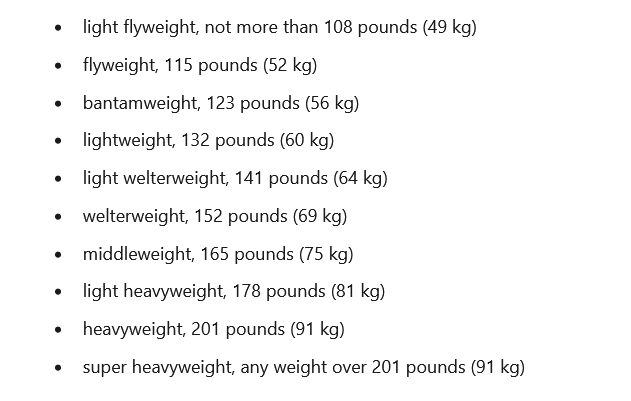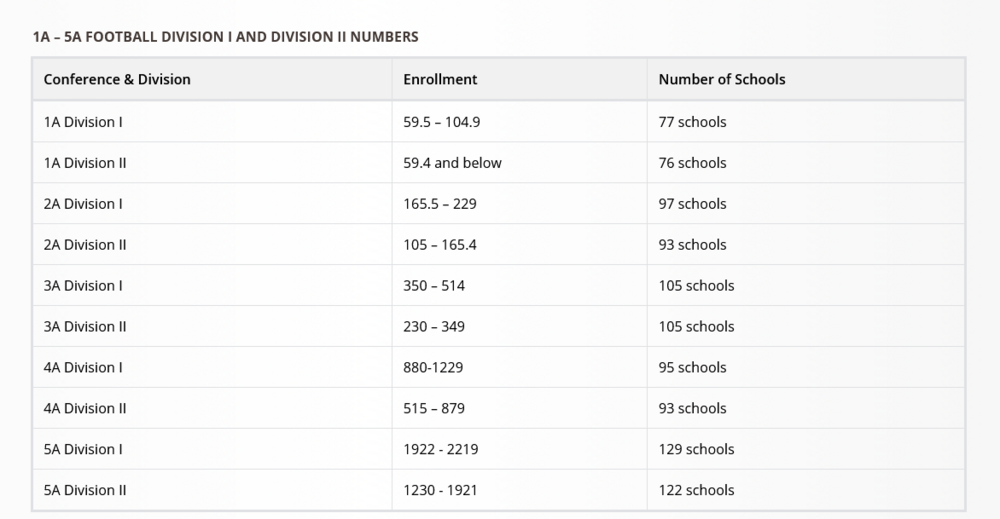-
Posts
6,586 -
Joined
-
Last visited
-
Days Won
190
Content Type
Profiles
Forums
Gallery
Store
Articles
Events
Everything posted by foxbat
-

Plymouth Rockies
foxbat replied to Football Guru 25's topic in The Indiana High School Football Forum
One thing that's always perplexed me in high schools is the idea of Lady *fill in the blank*. For example, if your team mascot is Wildcats, why is the boys' basketball team the Wildcats and the girls' basketball team the Lady Wildcats? Aren't all of the students of that school Wildcats? -
Not sure how you got "gotcha" as: 1) I was responding to @Bobref's post, not yours 2) I was agreeing with his premise It is interesting though that you also seemed to miss my other comment to him as well that seems to question the reasoning of said restriction if there was some other item that it was supposed to be tied to:
-
If you are looking for Olympic sports that ban certain weights either directly or indirectly, here you go: Lightweight rowing. Lightweight rowing also exists at the high school and collegiate levels as well. Limitations are 150 lbs. for men and 130 lbs. for women in high school. Collegiate is 160 lbs. for men and 130 lbs. for women ... same levels as the Olympics. Bobsled has a de facto realistic limit because there are max weights for sled/crew combinations. Assuming the lightest sled possible, women have a top weight of, on average, 176.5 lbs. Minimum weights on the sleds are 364 lbs. for women, so anything heavier on the sled decreases the weight of the average sledder. For men, there's a bit more, but still a max weight limit for the sled and crew as a whole. For four-man, you are looking at max average weights of 231.5 lbs assuming the lightest sled weight possible at 463 lbs. Skeleton similarly has a de facto realistic limit. Max weight for men and equipment is around 254 lbs. For women it's around 204 lbs. Skeleton sleds tend to weigh in the 70 lb. range. An "overweight" man can have a sled with a max weight of 73 lbs., which basically puts the max weight of the sport right around 181 lbs. for men ... close to the 178 lb. limit for the sprint football sport.
-
Like in Olympic boxing: Although I do wonder what the reasoning for the 178 lbs. is. It would seem, since the idea of the sport is on speed and agility, that those would be the determining factors for play ... e.g., shuttle times, etc.
-

Plymouth Rockies
foxbat replied to Football Guru 25's topic in The Indiana High School Football Forum
Hobart has nearly 27% Hispanic, 8% Black and 47% FRL, yet they have done quite well at 8-4, 11-3, 11-3 and a visit to LOS in the last three seasons. -

Plymouth Rockies
foxbat replied to Football Guru 25's topic in The Indiana High School Football Forum
There aren't too many majority-Hispanic high schools in Indiana, but of the ones that are, their football teams aren't any more than .500 at best. River Forest is about 40% Hispanic and has boasted winning seasons the last three seasons. -
Oklahoma is a district-based alignment like Texas ... no conferences. Oklahoma split the 6A class for the first time back in 2014. Bixby just four-peated as 6A-II champ and has been in the state final all eight seasons that there has been a 6A-II ... having won seven of the eight seasons. BTW, who is Bixby? They are the largest team in 6A-II.
-

1A Oldenburg Academy Contracting
foxbat replied to a topic in The Indiana High School Football Forum
If you go here: http://www.ossaa.com/Football.aspx and click on the Class B and Class C links you can see what the Oklahoma 8-man playoffs looked like on scoring. In some cases there are definite shootouts, but in others they look like regular games ... you can click on the other class links to see the results of their 11-man playoffs. -

1A Oldenburg Academy Contracting
foxbat replied to a topic in The Indiana High School Football Forum
I'm with you on this. I'm wondering if any of them were teams that had and dropped football in the past or if they are all brand new. Also interested in seeing the make-up to see if there's anything in common, besides size, in these teams such as predominantly rural or predominantly P/P or predominantly lower SES. The reason that I'm interested is that, in Oklahoma, there are quite a few 8-man teams that have come from the ranks of teams that had been successful programs in 11-man ball in the state, but due to shifts in population densities or other schools opening had gotten smaller. Does anyone know if there's a requirement/limit in Indiana 8-man ball on school size to participate or, if not, a restriction on program and/or player that you can participate in 11-man or 8-man, but not both? I'm assuming that Indiana's current quarter limit, for the most part, would keep a player from playing full-time 8-man and and 11-man in the same week, but potentially could play the same way as a kid playing JV vs. varsity in a week ... i.e., a kid could play 2 quarters JV and 2 quarters of 8-man. -

Final USAToday sportspoll
foxbat replied to Trojanmp52's topic in The Indiana High School Football Forum
Hopefully not a dropped ball! -

Center Grove and Carmel - Back to The MIC?????????
foxbat replied to a topic in The Indiana High School Football Forum
Kind of like Keeping Up With The Kardashians? 😀 -

Center Grove and Carmel - Back to The MIC?????????
foxbat replied to a topic in The Indiana High School Football Forum
-

Center Grove and Carmel - Back to The MIC?????????
foxbat replied to a topic in The Indiana High School Football Forum
The HCC asked them to join, they accepted and the NCC terminated relationships with them a year before they were supposed to start with the HCC. Jeff ended up back in the NCC ... albeit about a decade after the NCC broke ties with Jeff. Of course, prior to Jeff heading over to the HCC they had spent somewhere around 70 years or so with the NCC. Jeff was with the NCC before heading to the HCC almost three times as long as the MIC's been around. -
Minnesota and Wisconsin have a reciprocity agreement for most of their state colleges ... you can get Minnesota in-state tuition if you are from Wisconsin and attend a Minnesota state school ... so it would seem that "cooperation" already exists between the two states to a degree.
-

Center Grove and Carmel - Back to The MIC?????????
foxbat replied to a topic in The Indiana High School Football Forum
There's also a chance that both will capitulate, drop 11-man football, and join in on the new 8-man program after the inaugural year. -

1A Oldenburg Academy Contracting
foxbat replied to a topic in The Indiana High School Football Forum
I'd be interested in seeing if the 13 mentioned here are new schools or just teams that are currently playing 11-man that are sliding to 8-man. If it's the former, it would would mean an increase in kids playing. -
Correct. The Division I and Division II are only figured out AFTER the playoff qualifying is determined. You are correct in that some schools will know they are going to be Division I or Division II fairly automatically. If you are one of the top largest in a district, you are going to be Division I and if you are one of the bottom two in size in a district, you are going to be Division II. If you are the third largest in a district, you could be in Division I or Division II ... same with the third smallest. Further adding a little jiggle to things is that some districts have ten teams in them and some only have six. The only one who is guaranteed, regardless of re-districting that occurs, is Allen. They are always going to be Division I because they are about 7,000+ and the largest school in the state. Unlike Carmel in Indiana, there's not as much grousing about them being a mega-school. Mega-schools, especially in Dallas, have been a way of playing the system since I was in high school back in the 70s. There used to be the Big Guys in Dallas like Richardson, Plano, and Lake Highlands, which is also where the money was at the time, that used to have huge schools. Plano finally split up albeit there's still something to the mega-school mystique. There are three Plano senior highs, Plano, Plano West, and Plano East, but they only house 11-12 grades in them. West has about 2,700, East has has about 2,900, and Plano has has about 2,600. They are fed by six 9-10 schools which house about 1,000 to 1,500 each.
-
Already has one ... it's called TAPPS: https://en.wikipedia.org/wiki/Texas_Association_of_Private_and_Parochial_Schools. Texas probably has around 75 teams playing P/P ball ... not including the 6-man teams.
-

GEICO State Champions Bowl Series
foxbat replied to Bobref's topic in The Indiana High School Football Forum
This was part of was getting at with the low-hanging fruit too. There are already schools in neighboring states that come to Indiana to play our teams like the schools out of Ohio and Kentucky and, if you toss LOS into the mix, I bet you could entice many other schools too. That basically makes the expenses relatively low for the Indiana participants. -
Kind of. The way that you are describing it is how it works for everything except 6A in Texas. There can be some decent-sized disparities within districts and in 6A. 6A spans from 7,000+ to around 2,200. My alma mater, which is out of an ISD with at least 12 6A schools in it, has roughly 3,300. Another school in our district only has around 2,300. The way Division I and Division II work in 6A for Texas is that, in a district, the top four teams advance to the playoffs. The largest two of those four go to Division I and the two smallest go to Division II. All things even, it should, theoretically have the largest teams playing each other and the smallest teams playing each other. You could, however, due to the fact that it is done post-season, have District A where the top four placement teams are the four largest in their district and the next-door district, District B, works out where its four smallest teams end up with the best records. District A's two smallest teams that place, and will go to Division II, could be larger than District B's two largest teams that place, which will go to Division I. Here are the classification cutoffs for Texas ... except 6A:









